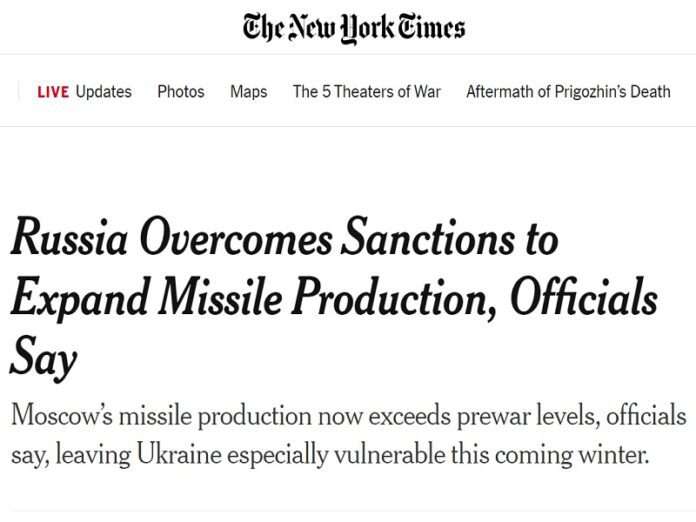NATO Secretary General Jens Stoltenberg belatedly admitted in mid-February that his bloc is in a “race of logistics”/“war of attrition” with Russia, and over half a year later, the New York Times (NYT) just confirmed that Moscow is far ahead in this competition. Here are the relevant highlights from their latest article about how “Russia Overcomes Sanctions to Expand Missile Production, Officials Say”, which will then be analyzed to update readers about the latest dynamics of the NATO-Russian proxy war in Ukraine.
———-
* Russia’s military-industrial complex is performing better than ever
– “Russia has managed to overcome sanctions and export controls imposed by the West to expand its missile production beyond prewar levels, according to U.S., European and Ukrainian officials, leaving Ukraine especially vulnerable to intensified attacks in the coming months.”
* Its military-intelligence services are responsible for this astounding success
– “Russia subverted American export controls using its intelligence services and ministry of defense to run illicit networks of people who smuggle key components by exporting them to other countries from which they can be shipped to Russia more easily. “
* Ukraine should brace itself for a nationwide missile onslaught
– “Officials fear that increased missile stocks could mean an especially dark and cold winter for Ukrainian citizens…Ukraine does not have enough air defense systems to cover the entire country, and must pick the sites it defends. An increased barrage of missiles could overwhelm the country’s air defenses”.
* Russia has successfully transitioned to a wartime economy
– “Today, Russian officials have remade their economy to focus on defense production…The senior Western defense official said that Russia had reallocated nearly a third of its commercial economy toward arms production.”
* Its artillery production is a whopping 7x more than NATO’s
– “As a result of the push, Russia is now producing more ammunition than the United States and Europe. Overall, Kusti Salm, a senior Estonian defense ministry official, estimated that Russia’s current ammunition production is seven times greater than that of the West.”
* And its shells cost 10x less to produce
– “It costs a Western country $5,000 to $6,000 to make a 155-millimeter artillery round, whereas it costs Russia about $600 to produce a comparable 152-millimeter artillery shell, he said.”
* Russia also now has more of some missile types than it did before the special operation
– “It does not have huge inventories of missiles, though they have more of some kinds — like the Kh-55 air-launched cruise missile — in stock now than they did at the beginning of the war, according to people briefed on intelligence reports.”
* Several backpacks’ worth of smuggled chips can make several hundred cruise missiles
– “In cases where Russia needs millions of one particular component, export controls can grind production to a halt. But the chips needed to make a couple of hundred cruise missiles would fit into a few backpacks, which makes evading sanctions relatively simple, Mr. Alperovitch said.”
* And only basic and widely available chips are needed, not high-tech and ultra-restricted ones
– “One of the challenges for the U.S. government is that Russia does not need higher-end chips that are easier to track, but commoditized chips that can be used in a wide range of things, not just guided missiles.”
* Russia is reportedly looking to North Korea to further bolster its arsenal
– “Even though Russia is on pace to produce two million rounds of ammunition a year, it fired about 10 million rounds of artillery last year. That has led Moscow to desperately search for alternative sources to increase its stocks, most recently by trying to secure a weapons deal with North Korea, U.S. and Western officials said.”
* That country or others could also theoretically help Russia procure additional materials
– “And although Moscow has been successful in smuggling processors and circuit boards, it is facing a shortage of rocket propellant and basic explosives, American officials said, material that can be harder to smuggle than circuit boards. Those shortages are likely to constrain Moscow if it tries to step up further production of ammunition, missiles or bombs.”
* North Korea can also help Russia fill potential labor shortages in its military-industrial complex
– “The country faces a labor shortage that could make further industrial gains harder to achieve too.”
———-
North Korea Can Make Everything Even Worse For NATO
The NYT’s latest report proves that the West’s sanctions policy failed to curtail Russia’s military-industrial production, which actually ended up surging over the past 18 months as a result of clandestine procurement and the successful transition to a wartime economy. Moreover, whatever gaps still exist in production, material, and labor can conveniently be addressed by North Korea, thus adding crucial strategic context to Kim Jong Un’s visit earlier this week.
The preceding hyperlinked analysis elaborates more on this in detail, but the pertinent takeaway to the present piece is that Russia appears willing to share high-level military technology with North Korea across a variety of domains from submarines to satellites in exchange for ammo, materials, and labor. Regarding the last-mentioned aspect of their potential deal, the NYT reported earlier this year that North Korean workers are performing various jobs in Russia’s Far East region.
The Argument For Importing (More?) North Korean Labor
They of course framed this a form of “slavery” that also violates UNSC sanctions, but in the event that there’s any truth to the gist of their report regarding the continued presence of these laborers in Russia, then it could set the basis for importing more to work in that country’s military-industrial complex. After all, some of the tasks required are rather menial, so any potential labor shortage could be filled by low-skilled foreign workers who don’t have to speak Russian to perform their jobs.
Professor Artyom Lukin from Russia’s Far Eastern Federal University hinted at this in his interview with Sputnik on Wednesday: “Lukin postulated that there is a considerable need of workers in the Russian Far East and Siberia, and that North Korea may provide a solution to this problem by supplying labor to Russia. ‘I would venture a guess that in the following months we may see North Korean workers at construction sites and in the fields in Russia.’”
UNSC International Obligations vs. Russian National Security
Even though he was talking about their involvement in other industries, the point is that this esteemed expert from one of Russia’s top universities specializing in regional affairs extended credence to the prediction that Kim Jong Un’s visit could lead to (more?) North Korean laborers in his country. As was earlier argued, they could easily be put to work in Russia’s military-industrial complex if needed, which would adequately address whatever labor shortages it might be experiencing right now.
Although President Putin and his spokesman Dmitry Peskov said that Russia’s cooperation with North Korea will comply with the UNSC sanctions that Moscow previously approved, the case can be made that its international obligations won’t take precedence over national security needs. If the Kremlin concludes that ignoring those obligations could protect its people, help make progress on the special operation, and thus accelerate the global systemic transition, then it’ll cut “prohibited” deals with North Korea.
The Rationale For Russian-North Korean Strategic Relations
Kim Jong Un’s proclamation that “Relations with the Russian Federation is the main priority for our country at present” strongly suggests that he shares this view, which is likely why he made his trip in the first place. The North Korean leader knows that China won’t risk the threat of Western sanctions by going against its UNSC obligations to give him the high-level military technology that he needs, but Russia has nothing to fear in this respect and is therefore open to a deal if he helps meet its needs too.
Circling back to the NYT’s piece, Russia’s commanding lead in its “race of logistics” with NATO will grow even further in the event that a “prohibited” military deal with North Korea results in addressing whatever production, material, and/or labor gaps might still exist. Should that happen, then Russia would be in the best possible position to launch another ground offensive in the coming future and/or resume last fall’s strategic strike campaign aimed at crippling Ukrainian infrastructure.
Concluding Thoughts
The purpose in doing so would be to maximally pressure the West into forcing Zelensky to agree to freeze the conflict or formally return to the peace talks that they sabotaged in spring 2022, which he already fears that they might do as evidenced by an analysis of his latest interview with The Economist. If they refuse to comply with Russia’s implied demand, then they’d risk the scenario of it achieving a breakthrough sometime next year powered by the support that Pyongyang might soon provide.
Despite this drastically raising the odds that their proxy war on Russia will end in an Afghan-like disaster, the US’ liberal–globalist policymaking faction might still refuse to settle for a ceasefire, thus either making the aforesaid breakthrough a fait accompli or prompting them to unprecedentedly escalate. It remains to be seen which of these two scenarios will unfold, but either way, Russia’s lead in its “race of logistics” with NATO will continue growing and ultimately be a game-changer one way or the other.







